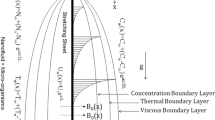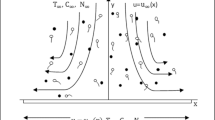Abstract
The aim of this paper is to develop a theory describing the onset of convection instability (called here nanofluid bioconvecion) that is induced by simultaneous effects produced by oxytactic microorganisms, nanoparticles, and vertical temperature variation. The theory is developed for the situation when the nanofluid occupies a shallow horizontal layer of finite depth. The layer is defined as shallow as long as oxygen concentration at the bottom of the layer is above the minimum concentration required for the bacteria to be active (to actively swim up the oxygen gradient). The lower boundary of the layer is assumed rigid, while at the upper boundary both situations when the boundary is rigid or stress free are considered. Physical mechanisms responsible for the slip velocity between the nanoparticles and the base fluid, such as Brownian motion and thermophoresis, are accounted for in the model. A linear instability analysis is performed, and the resulting eigenvalue problem is solved analytically using the Galerkin method.
Similar content being viewed by others
References
Do K.H., Jang S.P.: Effect of nanofluids on the thermal performance of a flat micro heat pipe with a rectangular grooved wick. Int. J. Heat Mass Transf. 53, 2183–2192 (2010)
Ebrahimi S., Sabbaghzadeh J., Lajevardi M., Hadi I.: Cooling performance of a microchannel heat sink with nanofluids containing cylindrical nanoparticles (carbon nanotubes). Heat Mass Transf. 46, 549–553 (2010)
Fan X., Chen H., Ding Y., Plucinski P.K., Lapkin A.A.: Potential of ‘nanofluids’ to further intensify microreactors. Green Chem. 10, 670–677 (2008)
Li H., Liu S., Dai Z., Bao J., Yang X.: Applications of nanomaterials in electrochemical enzyme biosensors. Sensors 9, 8547–8561 (2009)
Munir A., Wang J., Zhou H.S.: Dynamics of capturing process of multiple magnetic nanoparticles in a flow through microfluidic bioseparation system. IET Nanobiotechnol. 3, 55–64 (2009)
Huh D., Matthews B.D., Mammoto A., Montoya-Zavala M., Hsin H.Y., Ingber D.E.: Reconstituting organ-level lung functions on a chip. Science 328, 1662–1668 (2010)
Sokolov A., Goldstein R.E., Feldchtein F.I., Aranson I.S.: Enhanced mixing and spatial instability in concentrated bacterial suspensions. Phys. Rev. E 80, 031903 (2009)
Tsai T., Liou D., Kuo L., Chen P.: Rapid mixing between ferro-nanofluid and water in a semi-active Y-type micromixer. Sens. Actuators A-Phys. 153, 267–273 (2009)
Shitanda I., Yoshida Y., Tatsuma T.: Microimaging of algal bioconvection by scanning electrochemical microscopy. Anal. Chem. 79, 4237–4240 (2007)
Hillesdon A.J., Pedley T.J., Kessler J.O.: The development of concentration gradients in a suspension of chemotactic bacteria. Bull. Math. Biol. 57, 299–344 (1995)
Hillesdon A.J., Pedley T.J.: Bioconvection in suspensions of oxytactic bacteria: linear theory. J. Fluid Mech. 324, 223–259 (1996)
Metcalfe A.M., Pedley T.J.: Bacterial bioconvection: weakly nonlinear theory for pattern selection. J. Fluid Mech. 370, 249–270 (1998)
Metcalfe A.M., Pedley T.J.: Falling plumes in bacterial bioconvection. J. Fluid Mech. 445, 121–149 (2001)
Pedley T.J.: Instability of uniform micro-organism suspensions revisited. J. Fluid Mech. 647, 335–359 (2010)
Kuznetsov A.V.: Thermo-bioconvection in a suspension of oxytactic bacteria. Int. Commun. Heat Mass Transf. 32, 991–999 (2005)
Kuznetsov A.V.: Investigation of the onset of thermo-bioconvection in a suspension of oxytactic microorganisms in a shallow fluid layer heated from below. Theor. Comput. Fluid Dyn. 19, 287–299 (2005)
Kuznetsov A.V.: The onset of thermo-bioconvection in a shallow fluid saturated porous layer heated from below in a suspension of oxytactic microorganisms. Eur. J. Mech. B-Fluids 25, 223–233 (2006)
Avramenko A.A., Kuznetsov A.V.: Bio-thermal convection caused by combined effects of swimming of oxytactic bacteria and inclined temperature gradient in a shallow fluid layer. Int. J. Numer. Methods Heat Fluid Flow 20, 157–173 (2010)
Kuznetsov A.V., Avramenko A.A.: Effect of small particles on the stability of bioconvection in a suspension of gyrotactic microorganisms in a layer of finite depth. Int. Commun. Heat Mass Transf. 31, 1–10 (2004)
Geng P., Kuznetsov A.V.: Effect of small solid particles on the development of bioconvection plumes. Int. Commun. Heat Mass Transf. 31, 629–638 (2004)
Geng P., Kuznetsov A.V.: Settling of bidispersed small solid particles in a dilute suspension containing gyrotactic micro-organisms. Int. J. Eng. Sci. 43, 992–1010 (2005)
Kuznetsov A.V., Geng P.: The interaction of bioconvection caused by gyrotactic micro-organisms and settling of small solid particles. Int. J. Numer. Methods Heat Fluid Flow 15, 328–347 (2005)
Geng P., Kuznetsov A.V.: Introducing the concept of effective diffusivity to evaluate the effect of bioconvection on small solid particles. Int. J. Transp. Phenom. 7, 321–338 (2005)
Kuznetsov A.V.: Non-oscillatory and oscillatory nanofluid bio-thermal convection in a horizontal layer of finite depth. Eur. J. Mech. B/Fluids. 30, 156–165 (2011)
Buongiorno J.: Convective transport in nanofluids. J. Heat Transf.-Trans. ASME 128, 240–250 (2006)
Nield D.A., Kuznetsov A.V.: The onset of convection in a horizontal nanofluid layer of finite depth. Eur. J. Mech. B/Fluids. 29, 217–223 (2010)
Nield D.A., Kuznetsov A.V.: The effect of local thermal nonequilibrium on the onset of convection in a nanofluid. J. Heat Transf.-Trans. ASME 132, 052405 (2010)
Anoop K.B., Sundararajan T., Das S.K.: Effect of particle size on the convective heat transfer in nanofluid in the developing region. Int. J. Heat Mass Transf. 52, 2189–2195 (2009)
Krishnamurthy S., Lhattacharya P., Phelan P.E., Prasher R.S.: Enhanced mass transport in nanofluids. Nano Lett. 6, 419–423 (2006)
Finlayson B.A.: The Method of Weighted Residuals and Variational Principles. Academic Press, New York (1972)
Chandrasekhar S.: Hydrodynamic and Hydromagnetic Stability. Clarendon Press, Oxford (1961)
Author information
Authors and Affiliations
Corresponding author
Rights and permissions
About this article
Cite this article
Kuznetsov, A.V. Nanofluid bioconvection: interaction of microorganisms oxytactic upswimming, nanoparticle distribution, and heating/cooling from below. Theor. Comput. Fluid Dyn. 26, 291–310 (2012). https://doi.org/10.1007/s00162-011-0230-1
Received:
Accepted:
Published:
Issue Date:
DOI: https://doi.org/10.1007/s00162-011-0230-1




